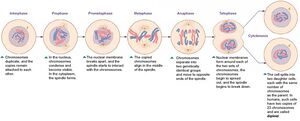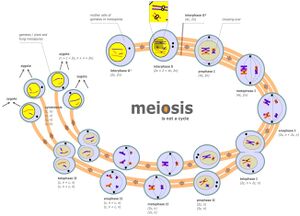Cell division – mitosis and meiosis
Cell Division – mitosis, meiosis
Cell division, known as Mitosis, involves the splitting of a parent cell into two daughter cells, with each daughter cell inheriting an identical set of chromosomes to that of the parent cell. The phase between mitotic divisions is referred to as interphase, during which DNA replication takes place, resulting in the characteristic appearance of the nucleus as commonly observed in histological preparations.
P (Professor) M (Met) A (Ana) T (Talpen)
• Prophase: During this stage, the replicated chromatin condenses into rod-shaped structures called chromosomes, each composed of duplicate sister chromatids. The centrosomes containing centrioles move apart to opposite poles of the cell, while microtubules of the mitotic spindle form between them. Additionally, transcriptional activity ceases in the nucleolus, which subsequently disappears. Later in prophase, the nuclear envelope disintegrates.
• Metaphase: In metaphase, the condensed chromosomes align along the equatorial plate or the center of the cell, with their kinetochores attached to microtubules of the mitotic spindle. The kinetochore, a protein structure on chromatids, facilitates the attachment of spindle fibers during cell division and ensures the organized arrangement of chromosomes.
• Anaphase: During anaphase, the sister chromatids separate and are gradually pulled towards opposite spindle poles by kinesin motors moving along the microtubules.
• Telophase: At this stage, the two sets of chromosomes reach the spindle poles and begin to decondense back into their non-condensed state. The microtubules of the spindle depolymerize, and the nuclear envelope starts to reform around each set of daughter chromosomes. Concurrently, during cytokinesis, a contractile ring composed of actin filaments forms in the peripheral cytoplasm. This ring contracts, dividing the cytoplasm and its organelles into two daughter cells, each containing one nucleus.
Meiosis is a specialized type of cell division occurring exclusively during the formation of sperm and egg cells, also known as gametes. The resulting cells are haploid (n, 23), containing only one chromosome from each homologous pair found in the somatic cells of the body. When a haploid egg and sperm cell unite during fertilization, they form a diploid zygote capable of developing into a new individual.
During Prophase I of meiosis, which is significantly elongated, chromatin condenses as usual. However, early in this process, homologous chromosomes undergo synapsis, physically pairing up to form structures called tetrads. This allows for the exchange of genetic material between maternal and paternal chromosomes, a phenomenon known as crossing over.
In humans, Prophase I is extended for approximately three weeks during male gamete production, while oocytes arrest in this phase from fetal ovary development through to reproductive maturity in females.
Following synapsis and crossing over, the chromosomes proceed through the stages of metaphase, anaphase, and telophase, ultimately resulting in the division of the cell into two daughter cells. During anaphase I, homologous chromosomes separate, each still consisting of two chromatids held together at the centromere.
Subsequently, each of the newly formed daughter cells undergoes a second division, known as meiosis II, where chromatids separate at the centromere and are pulled to opposite poles as individual chromosomes. This results in the production of four haploid cells from the original diploid cell.
In summary, while mitosis produces two diploid cells, meiosis comprises two rounds of cell division, generating four haploid cells. Meiotic crossing over leads to the creation of new combinations of gene alleles, resulting in each haploid cell being genetically unique. In contrast, mitosis lacks synapsis and DNA recombination opportunities, resulting in two genetically identical daughter cells.


